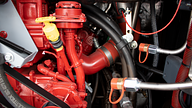Vehicle fire suppression systems
Fires in public transport vehicles such as buses and coaches can have serious implications that go beyond damage to the vehicle. If a fire is not detected and controlled rapidly, it can put passengers and drivers at risk. Public transport fires have a high profile, damaging the reputation of the bus operator.
Under UNECE Regulation 107, all new buses and coaches must be fitted with an automatic vehicle fire suppression system. This regulation aims to increase safety for passengers, drivers, and other road users, as bus fires starting in the engine compartment can quickly grow out of control.
An increase in zero-emission vehicles on the roads has raised awareness of the need for automatic fire suppression on these vehicles too, with electric vehicle fires causing significant damage and potential injury if the blaze is not contained before passengers and the driver are evacuated.
-

Rapid automatic fire suppression
Our dry chemical powder is highly effective at tackling most types of fire.
-

Reliable system operation
Our Linear Heat Detection (LHD) cable provides fast fire detection for maximum prevention.
-

Easy maintenance and long life
Simple upkeep procedures and a 10-year lifespan ensure minimal disruptions to operations.
Why is a vehicle fire suppression system needed?
Vehicle engines can overheat, leading to flying sparks that can ignite flammable materials nearby. If this happens, and automatic detection is not fitted to an engine compartment, fires on buses and coaches can go unnoticed… until the fire is already out of control. Since the engine is situated at the rear of the vehicle, vision is often obscured to the driver, so they might not detect the fire until smoke is billowing.
Quickly bringing the vehicle to a stop and evacuating passengers can be difficult, which is why our automatic detection systems are designed to detect and self-actuate quickly - allowing an operator to pull over and get all passengers out of the vehicle safely.
Fires on electric vehicles are also a hot topic, with vats of water required to effectively suppress the fire. Many fires that affect electric vehicles start outside of the battery compartment, but once they do reach it, this can cause thermal runaway in the battery cell, resulting in a rapidly growing fire. The most effective method to tackle fires on electric vehicles is to detect and suppress them before they cause thermal runaway in the battery cell, using a specially designed vehicle fire suppression system.
Want us to give you a call?
Request a CallbackThe ultimate vehicle fire suppression system
To protect buses, coaches, and other public transport vehicles, our automatic vehicle fire suppression systems are fitted to engine compartments and other fire hazard areas. These are specifically designed to detect the fire and self-actuate quickly, giving the driver time to pull the vehicle over and evacuate safely.
The Ardent R107-approved vehicle fire suppression system meets all UNECE R107 requirements for engine bay automatic fire suppression. This system has passed strict fire testing protocols from the Research Institutes of Sweden (RISE) which have been adopted from the SP Method 4912 tests.
Ardent vehicle fire suppression systems offer reliable, automatic fire detection and actuation. The linear heat detection cable provides rapid fire detection while protecting against false discharges commonly caused by loss of pressure in tube systems, reducing unnecessary downtime. Meanwhile, the dry chemical suppression agent is proven to be the most effective agent for the protection of diesel, electric, hybrid, and hydrogen fuel cell vehicles.
Our vehicle fire suppression system can also be linked to our driver message unit. This allows audible warnings to be delivered to the bus driver through a speaker installed in their cab, alerting the driver if a fire or high temperature condition is detected.
Learn more about vehicle fire suppression systems
Read MoreService and support for vehicle fire suppression systems
At Ardent, we understand the impact of vehicle downtime on bus and coach operations and productivity. That's why it’s not only our vehicle fire suppression systems that are always ready to detect and suppress a fire, and our dedicated team is equally ready to respond to callouts within a matter of hours. Our fire suppression systems are powered by a team who listens, understands the transport industry’s needs, and fits seamlessly into operations to provide the highest service standards.
Some vehicles we protect:
- Buses
- Coaches
- Minibuses
- City buses
Related Content


Fire Suppression Basics: Fire Hazard Analysis
In this post, we look at the principles behind a fire hazard analysis and how they dictate system design parameters such as quantity of suppression agent.







